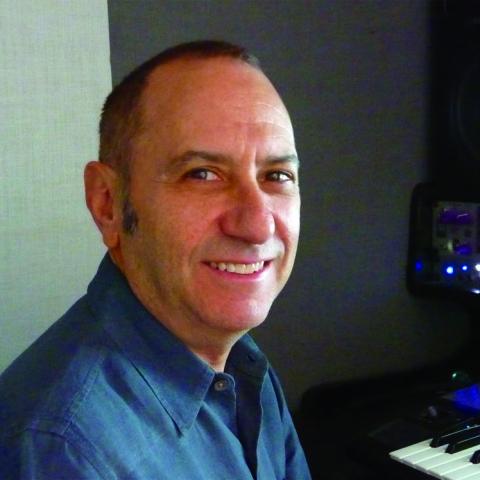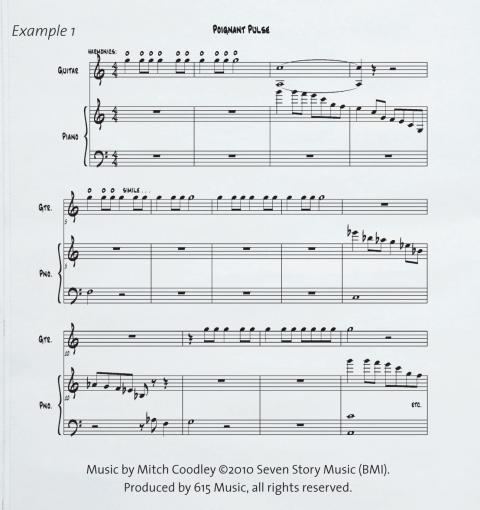The Power of Patterns

Mitch Coodley has composed music for TV, new, sports, and jingles, and was founder of Metro Music Productions, Inc. He welcomes your comments and demos at mitch@mitchcoodley.com.
Sometimes the introduction to a song gives us a thrill or goose bumps. It’s like love at first hearing. Some songs just feel special right from bar one. The start of a song is a unique moment, an exciting one that we love to replay over and over.
The song “Every Breath You Take” by the Police is such an enduring hit partly because of the muted guitar pattern that Andy Summers plays. It has a magnetism that draws you in, keeps you immersed, and yet drifts into the background under Sting’s vocal. It sits there, along with the backbeat, like a musical yellow brick road and leads us down its comfortable I, VI, IV, V path. It’s like a never-ending intro that’s beguilingly simple.
I’ve written hundreds of instrumental songs for TV. Producers have auditioned many of them for only a few seconds, so a strong introduction is critical. Knowing this, I often build patterns into intros from arpeggiated guitar parts, sequencer patterns, pattern pulse parts, and repeating riffs (ostinatos). I often weave these parts into the texture of the song. When done well, these patterns become integral to the song, the sound, the feel, the aural fabric.
With vocal music, these patterns create the underpinning of a song for the singer. For TV or film background music, instrumental beds should provide mood, lift, and some momentum without getting in the way of the dialogue or voice-over. To deliver interesting instrumental pieces unaided by vocals, you need to be creative.
Patterns to Animate the I Chord
The current style in TV music tends toward moody grooves, ticky-tech percussion, and atmospheric pads with simple chord patterns that usually start on the I chord. How do you generate movement, color, and texture on the all-important tonic chord? I always start simple, and simplicity rarely fails to please. After that, you can begin your chord progression. Let’s look at several approaches.
“Poignant Pulse” is an introspective piece suitable for a documentary (see example 1 on page 29). I use a simple ostinato and a pattern pulse—both basic elements of instrumental writing. I start with the minimum: one note. In this example, mood and tempo are established with an ostinato consisting of a guitar harmonic on the note G. Later, the piano enters with simple descending arpeggios, first in A minor, then in C minor, accompanied by a string pad. I vary the ostinato slightly by cross-panning it at first and later playing it up an octave, but it’s just one note: G.
Later in the piece, the piano part is energized, becoming a 16th-note pattern pulse* that could even serve as a stand-alone variation cue. Also note that two pauses provide space and additional anticipation. So it’s pattern-plus-pattern.
Layered-Guitar Arpeggiation
Guitar parts are the lifeblood of popular music. And in contemporary music, catchy guitar lines and textures are immensely important. For arpeggiated and sustained picking patterns, I recommend open strings to add sustain, brilliance, and occasional note doubling. The keys of E, A, D, G, and their relative minors offer the most open strings. Use of a capo makes open strings available for pieces in other keys.
In “Father Time,” a soft new-age-sounding acoustic song in A major, two fairly simple guitar arpeggio patterns merge to create the textural intro (see example 2). I’ve added an eighth-note stereo delay to the first guitar part to create an airy, transparent texture with the repeating notes.
There is some serendipity here too. For the first part, I actually played the first B note on the downbeat but also did some time shifting. Using Logic Pro, I delayed it by an eighth-note so that the pattern began on the upbeat. While most guitarists would find it easy to play the pattern starting on the downbeat, it’s tricky to play as written beginning on the upbeat. This shift creates ambiguity and, with the second guitar part, some nice accidental rhythmic rubs.
Minor Key Sequencer Pattern
“Survival” uses a typical generic drama element: a minor-key sequencer part (see example 3). Here I’ve used an ethnic plucked-string sample, but it could be almost any sound with a “point” to it, such as nylon-string guitar, synth element, harp, keyboard, marimba, and so on. Next, to create urgency and pacing, I built a world-percussion bed under it. A marcato string pattern pulse cements D Aeolian as the tonal center and supports the sequencer part. The result is a semi-orchestral “world adventure” piece that could fit as an incidental cue for the Survivor TV series.
The Hybrid Pulse Pattern
“Nightsounds” layers three simple parts: a slightly crunchy, sustained guitar chord, a soft-synth pattern pulse, and a muted acoustic guitar pattern (see example 4). The three parts work together to leave space and fill in the gaps. To add to the pulse, the electric guitar part has a light eighth-note delay. Later, a soft piano melody appears in the gaps, but the full effect has already been established by the backing textures alone.
You’ll also notice that these parts either fill in the gaps or overlap one another, and I think this is the most organic approach. Usually I leave room for such parts under a sustained note or during a pause. But occasionally I let them sync up or overlap, as demonstrated here between the clean acoustic guitar and the synth pattern pulse. These sounds contrast, and where they sit in the mix is important.
At the bridge, there is yet another pattern, with a guitar strumming in 16th notes. Later, the guitar and piano parts trade off in a call-and-response scheme.
Conclusion
Patterns are everywhere: on the sidewalk, in building architecture, in fabric, and in the stages of life. Patterns are an important foundation or platform on which to build a musical structure. Using repetition with variation will keep your listeners plugged in, pulsing, and on their toes.

Example 1

Example 2

Example 3

Example 4




